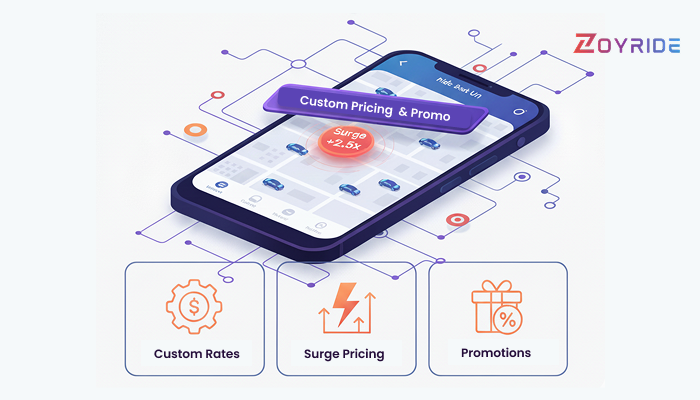
In today’s competitive ride-hailing and taxi business market, pricing is more than just a number — it’s a strategic tool. How you set your fares, manage peak-hour rates, and run promotions can directly impact your revenue, customer satisfaction, and driver retention.
If you operate a white-label rideshare or taxi booking software, you have a huge advantage — you can customize your pricing model based on your market, customer demand, and business goals. Let’s break down how to set up custom pricing, surge rates, and promotions in a way that boosts both profits and loyalty.
1. Understanding Custom Pricing in Your App
Custom pricing allows you to move beyond flat fares and set rates that adapt to different trip types, locations, or customer segments. This means you’re tailoring prices to match the unique needs of your market rather than sticking to one standard rate.
Setting Up Custom Pricing
- Base Fare Adjustments – Set different base rates for city vs. suburban trips.
- Distance & Time Rates – Adjust cost-per-kilometer and cost-per-minute depending on demand or region.
- Trip Type Pricing – One-way, round trips, and hourly rentals can each have their own rate structures.
Pro Tip: Use historical trip data to identify your most profitable routes and price them competitively while maintaining margins.
2. Setting Up Surge Rates
Surge pricing is a smart way to balance demand and supply. When passenger requests outnumber available drivers, fares increase temporarily to motivate more drivers to get on the road.
Configuring Surge Pricing
- Set trigger conditions — e.g., when demand is 20% higher than driver availability.
- Define multipliers — such as 1.5x, 2x, or custom rates depending on urgency.
- Control areas & times — apply only in specific locations or during peak periods like Friday nights or bad weather.
Why It Matters: Surge pricing incentivizes drivers to work during high-demand times and ensures passengers get rides faster.
3. Running Promotions to Boost Engagement
Promotions attract new users, re-engage existing ones, and keep your brand visible in a competitive market.
Creating Promotions
- Choose the Goal – Increase new sign-ups, fill off-peak hours, or reward loyalty.
- Select the Type of Offer
- First Ride Free/Discounted
- Happy Hour Discounts during quiet times
- Loyalty Coupons for frequent riders
- Driver Bonuses for trip completion targets
- Set Time Limits & Conditions – Avoid open-ended promos to protect profits.
- Track Redemption Rates – Check if the promotion is actually increasing trips.
4. Combining Pricing Strategies for Maximum Effect
The real advantage comes when you layer these tools together. For example:
- Custom Pricing for everyday operations.
- Surge Rates during high-demand hours.
- Promotions during quieter times to maintain steady demand.
By mixing strategies, you create a flexible pricing model that can adapt to changing market conditions without losing momentum.
5. Common Mistakes to Avoid
- Overcomplicating the Pricing Structure – Too many variables can confuse passengers and drivers.
- Ignoring Market Rates – If your prices are far higher than competitors without added value, you may lose customers.
- Running Promotions Without Tracking ROI – Discounts should drive measurable growth, not just reduce profit margins.
6. Monitoring and Adjusting Your Pricing
A “set and forget” approach doesn’t work in today’s market.
- Review weekly reports on trips, cancellations, and earnings.
- Test small changes before applying them across the platform.
- Collect feedback from both passengers and drivers.
Conclusion
Pricing, surge rates, and promotions aren’t just technical settings in your app — they’re levers you can pull to stay competitive, attract passengers, and keep drivers motivated. With the right mix of flexibility and data-driven decision-making, you can design a pricing model that grows with your business.
If you’re looking for a white-label ride-hailing solution that gives you full control over pricing, surge rates, and promotions, Zoyride offers a customizable platform built for scalability and market adaptability.
FAQs
Q1. How often should I update my pricing strategy? Most operators review their pricing weekly or monthly. The key is to analyze trip data and adjust when you notice shifts in demand, cancellations, or competitor pricing.
Q2. Will surge pricing upset customers? Not if it’s transparent. Clearly show passengers why the price is higher (e.g., peak demand or limited drivers). When explained well, most customers accept surge as a trade-off for faster rides.
Q3. What’s the best type of promotion for new users? First-ride discounts or free rides are most effective for onboarding new customers. They reduce hesitation and give users a risk-free way to try your service.
Q4. How can I make sure promotions don’t hurt my profits? Always set time limits, budget caps, and track redemption rates. Focus on promotions that encourage repeat usage, not just one-off discounts.
Q5. Can drivers benefit from promotions too? Absolutely. Offering bonuses for completing a certain number of trips keeps drivers motivated, especially during peak or off-peak hours.